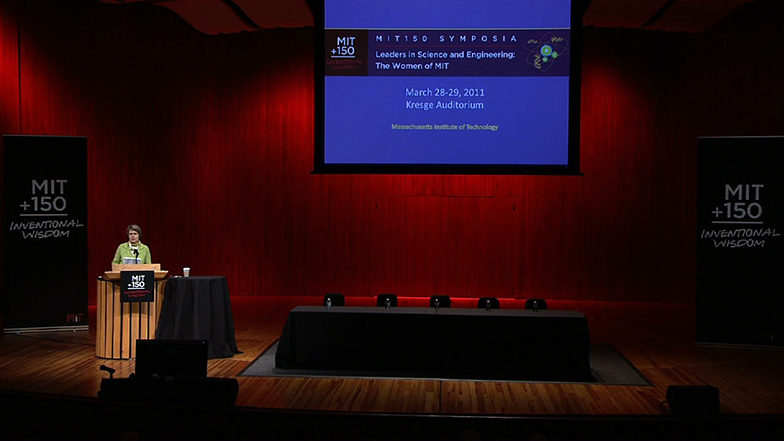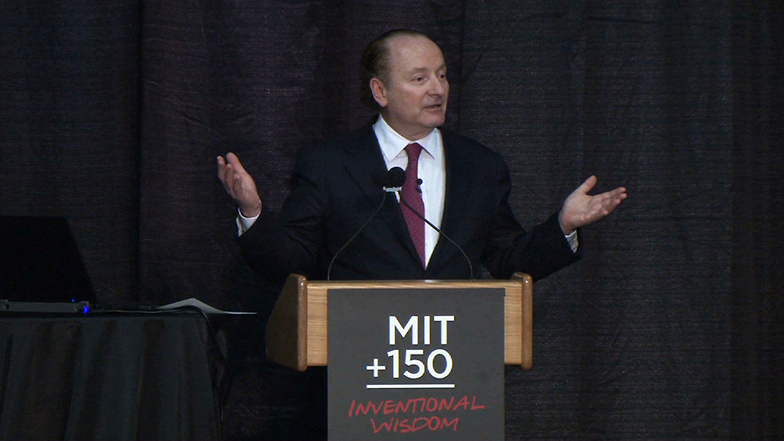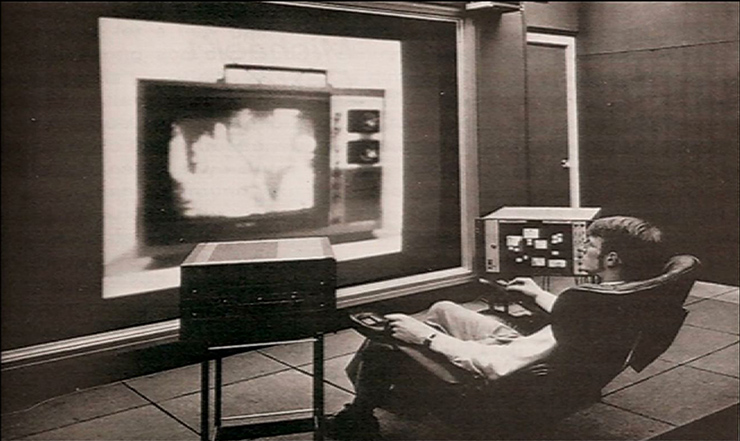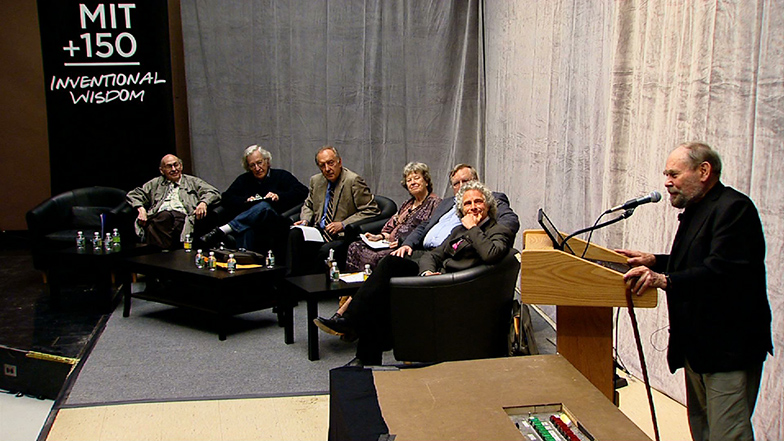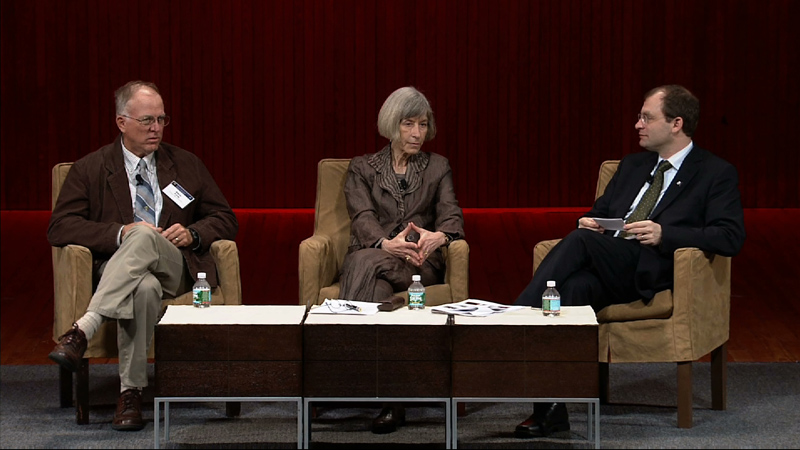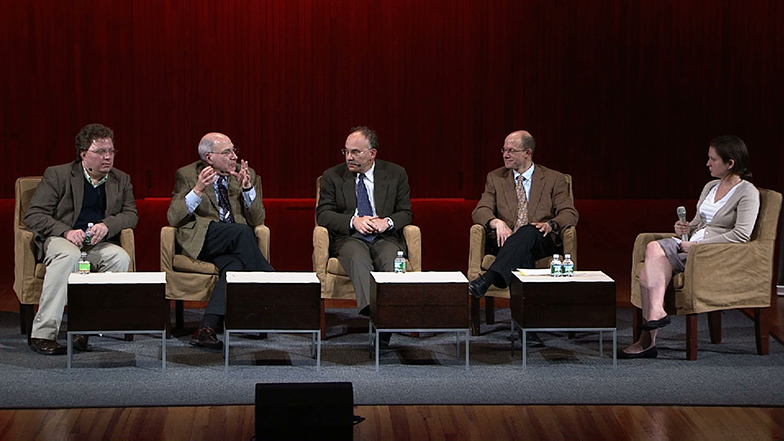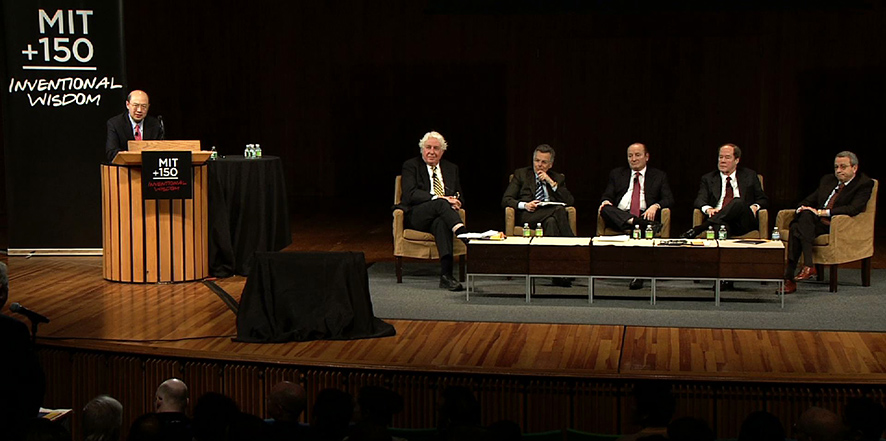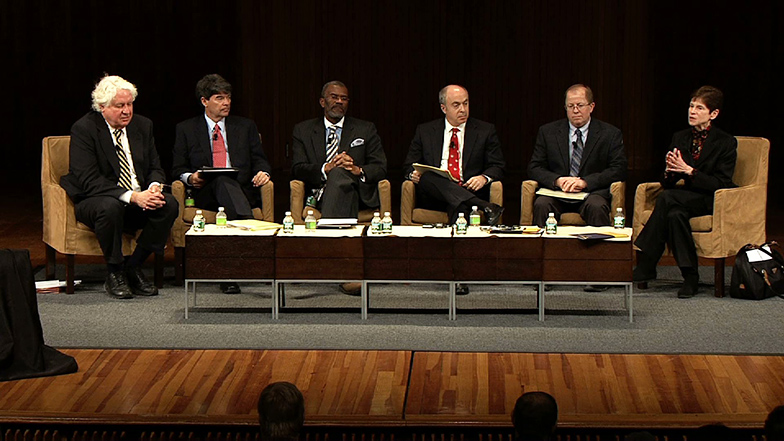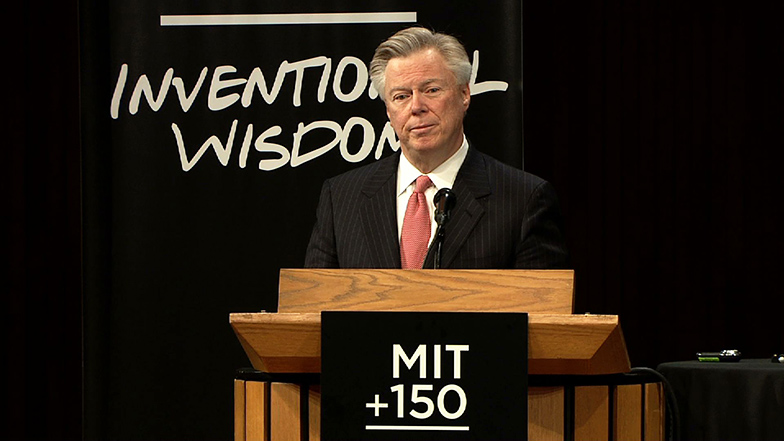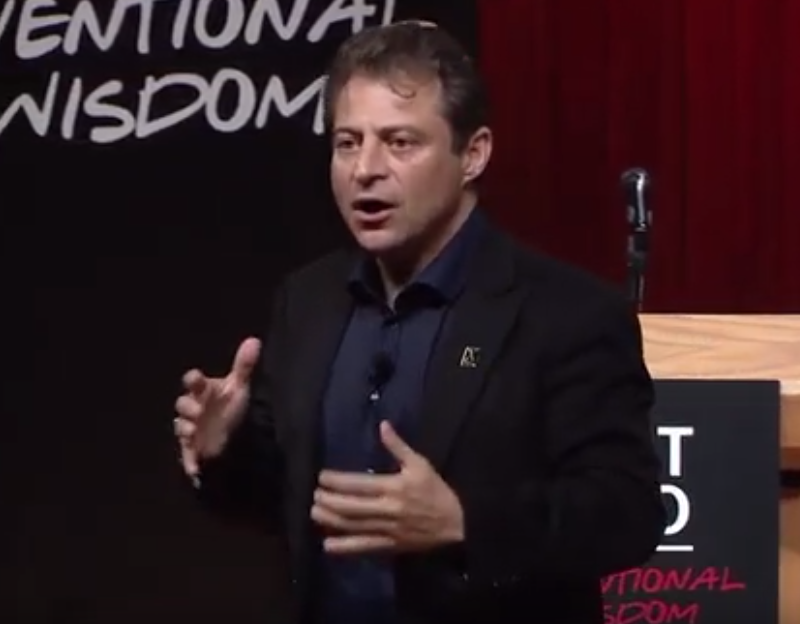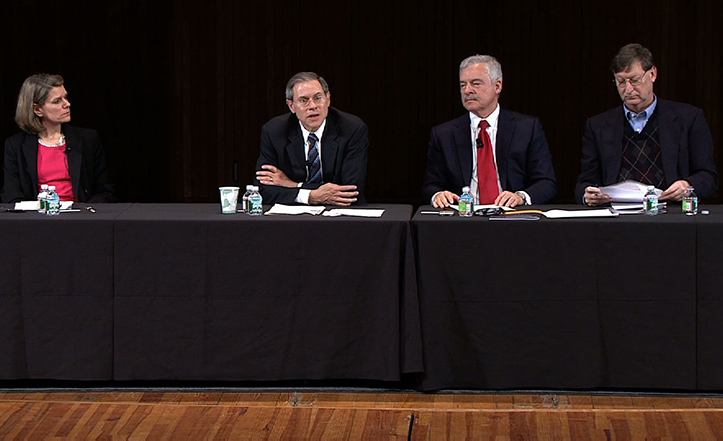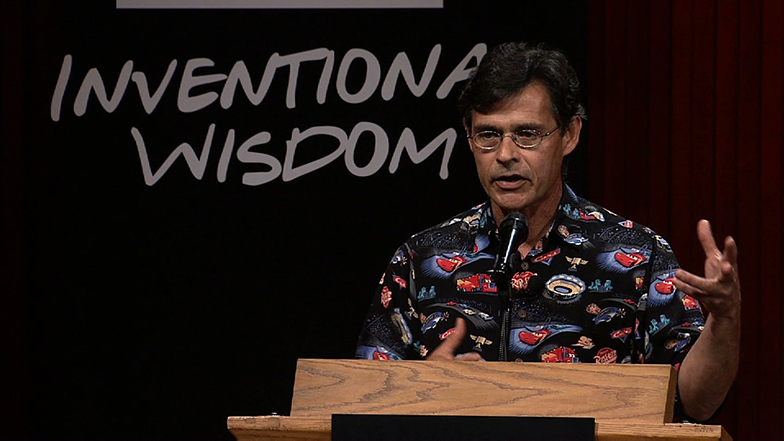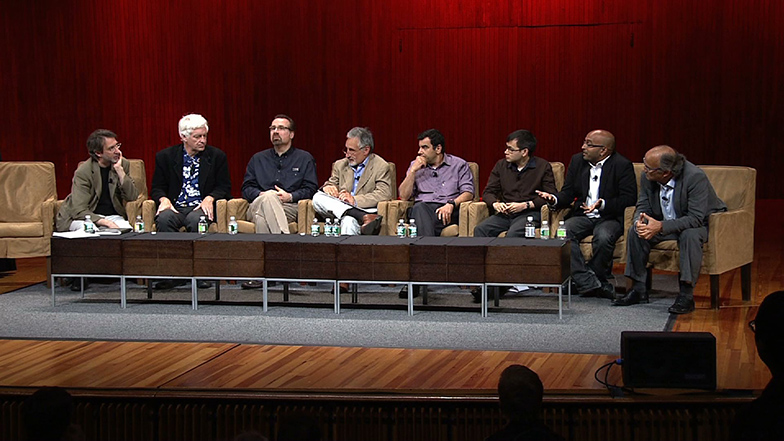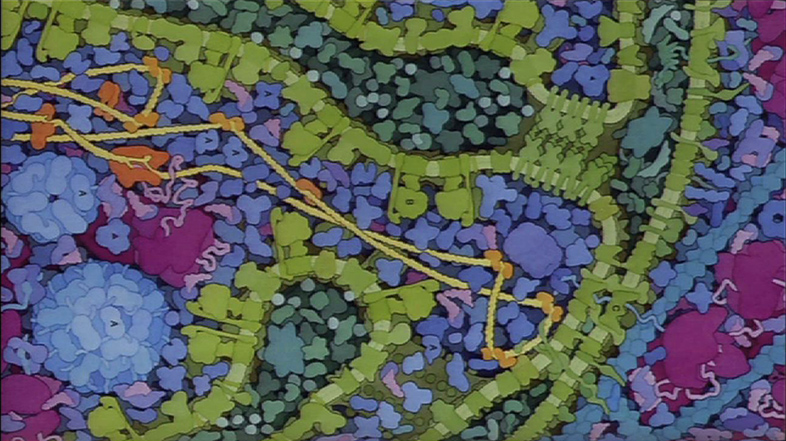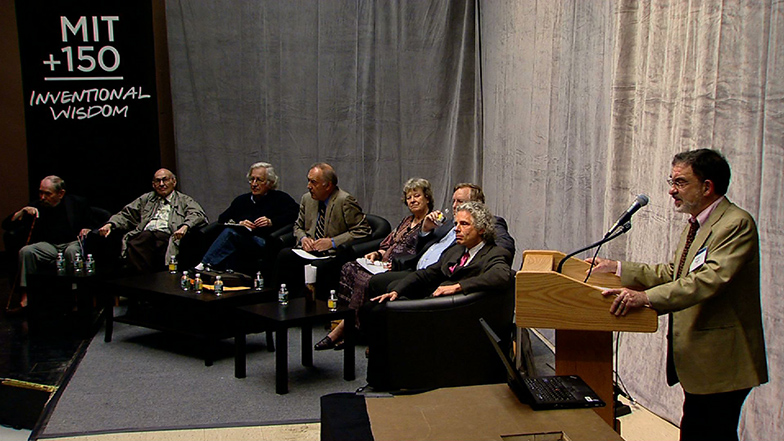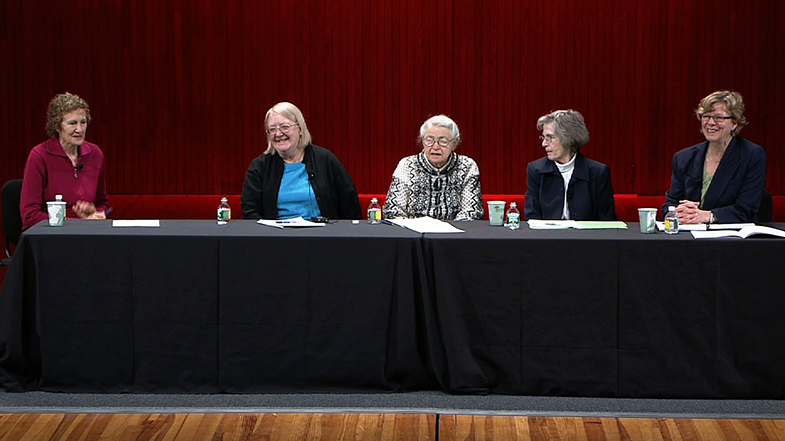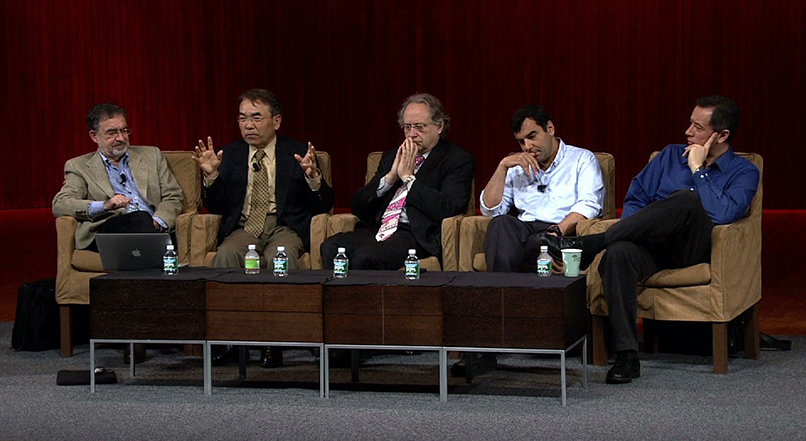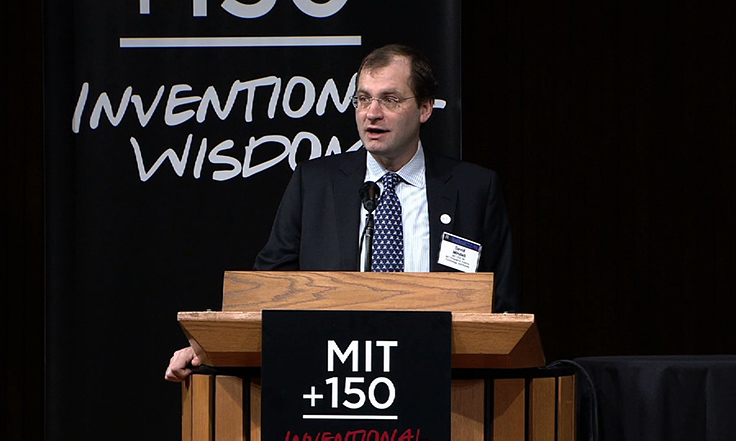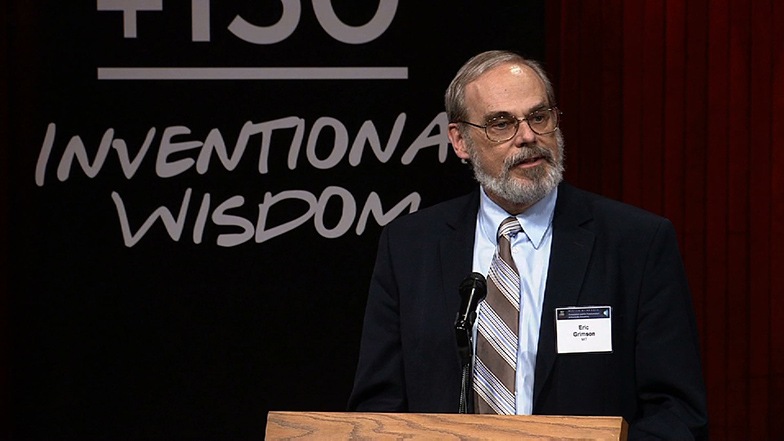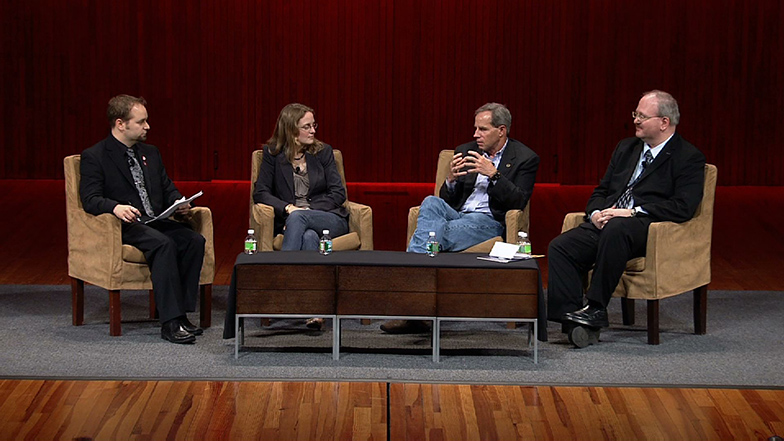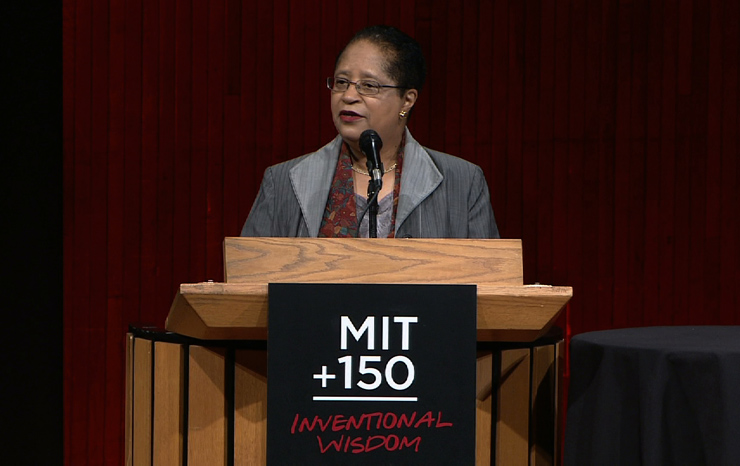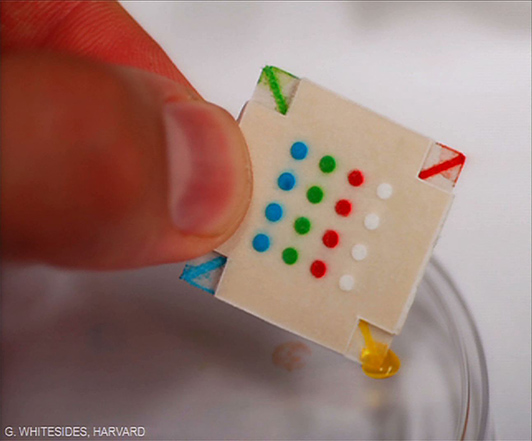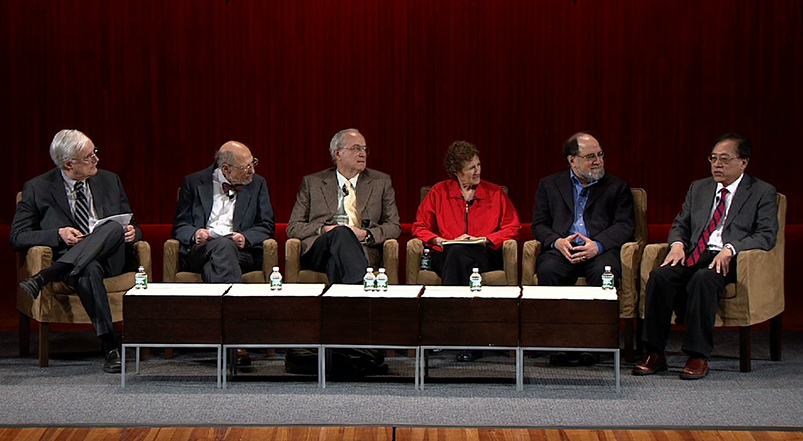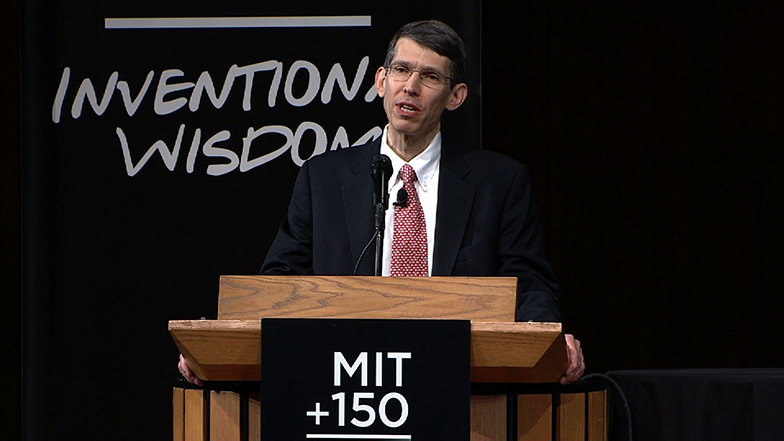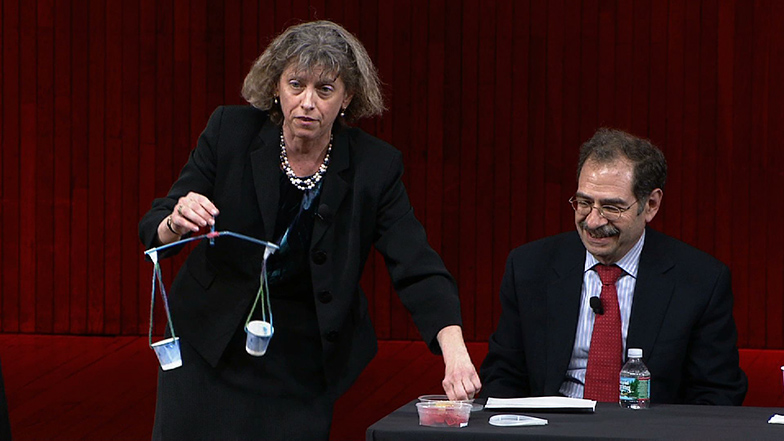Women of MIT: Celebrating Science and Engineering Breakthroughs (Session IV)
WEHRHEIM: Good I hope we're all ready and excited for one final round of celebrating science and engineering breakthroughs. My name's Katrin Wehrheim. I'm an associate professor of mathematics here. And I pushed for all these talks because I really wanted to know what successful women looked like who do fantastic research that gets them into the National Academy of Sciences. And so at least I'll get to see two more.
And I actually think the amazing talks have been so breathtaking. Also such good widely accessible talks that I will push hard to make this much more generally accessible, and somehow carry it all into until the middle schools, and high schools, and liberal arts colleges of this country, and maybe beyond this country to show what successful researchers look like if they happen to be female. So I'm very grateful to have two more.
So our first speaker in this last session is Penny Chisolm who is, to me, one of the most outstanding examples of an MIT lifetime career. Namely one that is, of course, based in stellar research that reaches across disciplines, and in her case, actually across schools. But which is also mixed with service to the Institute and sprinkled, of course, with distinguished prices and honors.
So Penny received her PhD in biology at SUNY Albany in the year I was born. Now you can do your math. She joined MIT before I could walk properly. And then, while I was learning to count, she already served as associate chair of the MIT faculty and co-authored also the 1999 report.
She is now a professor in both Biology in the School of Science, and in Civil and Environmental Engineering in the School of Engineering. And she runs her lab, as she says, as a highly collaborative ecosystem. And I think that's very appropriate because it also investigates the marine ecosystem. And that, again, is very appropriate because Penny herself discovered one of the cause of that ecosystem. But I will not give her more here because she probably can pronounce all those bacteria better than I can.
Let me just advertise her work with the fact that it got widely recognized by the Rosenstiel Award, a Huntsman Award, the Agassiz Medal, and, of course, she's a member of the National Academy of Sciences. So, Penny Chisholm telling us about tiny cells, global impact, and microbes in the seed.
CHISHOLM: Thank you. You're very sweet. Get all my tools here. Well, thank you all for being here this afternoon.
So last night I was thinking about giving this talk and I had an epiphany and I changed my title. So because I realized that what I'm going to tell you about today is about diversity. And it's the power of diversity within this one group of microbes which we would consider a species. But the diversity within this single species is absolutely extraordinary. So fundamentally that's my story today, is to tell you how this single species dominates the oceans through diversity.
So first I will talk about, very briefly, my view of life on Earth, and a little bit about ocean phytoplankton, which is the category of cells that our cell belongs to. And then about this Prochlorococcus which has been the target of my group's research since 1985. And I realized when I made this slide it looks like it died in 2011. But it didn't. It's alive and well. I'm just bringing this story up to 2011.
So, first life on Earth. And I always start my talks with this slide no matter what the talk is about because it's something that I learned from teaching introductory biology over and over and over again at MIT that, people absolutely do not appreciate or embrace the importance of this process, photosynthesis, on Earth. And that is that all of life, all of organic matter on Earth, with a few exceptions-- so I'm going to just be general here-- at least on today's Earth, comes from the atmosphere as CO2, through the sun's energy, and through plants, is fixed into organic carbon, and oxygen is evolved. And if it weren't for this, photosynthesis, that we would not have life on Earth as we know it. All of the organic matter is made by plants and these phytoplankton.
And then, of course, the reverse is the rest of us, animals, and bacteria, and everything else, uses that organic matter to be alive. And breaks it down, and makes CO2, and uses oxygen. But this is basically the most important biochemical reaction on Earth.
And what got me worked up about it is that, if you look in the introductory biology textbooks, it's just another chapter. It's not put there as though it's the beginning. And, for example, they often teach, in the textbooks, they'll teach respiration first as though this organic carbon just sort of appeared and has always been here. Because we're so centered on our own metabolism, we forget that without the plants and without photosynthesis, none of this would be there.
So I'm so passionate about it, that I actually wrote a children's book with-- and so I'm just taking advantage of this audience to give this a plug-- a children's book on photosynthesis. How the sun-- how plants bring earth to life. And if you want to hear anything more about that, we can talk about it later.
Okay. So here's the way the Earth works. You have photosynthesis on land, and you have photosynthesis in the oceans by these microscopic plants called phytoplankton. And billions of tons of carbon go through this every year.
But here's the flux of carbon in photosynthesis and land plants. And here's the flux into these microscopic plants in the oceans every year. I round this one up and this one down, so phytoplankton seem equally important. But anyway there's huge uncertainties in these numbers. So roughly half the photosynthesis on Earth occurs in the oceans.
And this is-- in spite of the fact that if you look at all the living plant biomass on land-- you have 600 to 1,000 gigatons-- whereas the biomass of the phytoplankton, these microscopic things, is just a tiny. And yet they can do roughly the same amount. And that's because they're just lean, little photosynthesis machines. They just can crank out. They don't have to maintain trunks and stems and all that kind of stuff.
So phytoplankton are incredibly diverse and beautiful. Different species have different shapes and sizes. And I call these the charismatic phytoplankton because they're beautiful and have all these features. But the one that I'm going to talk about today is Prochlorococcus, which is this tiny, tiny, tiny little round green thing. Not so beautiful, but it's extraordinary.
So that's the focus of the rest of the tale, and here are some features of this little cell. It's less than a micron in diameter. And for the non-scientists in the audience, you could line up 100 of these on the width of a human hair. They're extremely small.
And for the physicists, I was reminded by a physicists that these guys are the size of the wavelength of light that they're absorbing to photosynthesize, which is a great image. I love to think of these little cells with this light wavelength going-- I know it doesn't look like that, but that's how it is in my head. And they're the most abundant and the simplest photosynthetic cell on the planet, and we didn't know they existed until 1985.
Here they are in different resolutions. And the way they were discovered was through a laser-based instrument that a very clever young man, Rob Olson, who is an instrument designer for biomedical research, but he threw it on an oceanographic ship and took it to sea, and we were able to see these small cells that fluoresced red in a laser focused on a flow cell. And that was their discovery.
They didn't get into culture until 1990, and they're still very-- they don't like to be in the lab. But we've managed to tame them to some degree.
And they have novel chlorophylls. They contain chlorophyll b, which is unusual for a prokaryotic cell. And they have an extra double bond in their chlorophyll pigment which is very convenient for us, because we can measure their abundance in the oceans just by measuring how much of this divinyl chlorophyll there is.
So the other thing that I've come to appreciate about Prochlorococcus over the years, it's sort of like a muse. The more you think about it, the more you think about life in different ways. And this little cell, I consider, the minimal life form because it has about 2000 genes. I'll talk more about that in a minute.
But that's the minimum amount of information it takes to make life simply from light, carbon dioxide, air, and all these inorganic compounds. I just call it rocks. So, rocks, air, light, a little information, and you've got Prochlorococcus. And it dominates the oceans. So that's a pretty amazing feat.
So how many are there? We've estimates-- this is more or less. That's a huge more or less because we really don't know, but about 10 to the 27th. So there's as many-- if this is all the Prochlorococcus in the oceans, they weigh as much as a billion humans, roughly, plus or minus. But anyway, they're tiny, but there are a lot of them.
And if you look at their distribution in the global oceans, and the fraction of the total amount of chlorophyll in the oceans, or the fraction of the total phytoplankton that they comprise, in the Pacific, in particular, there are huge-- they can be a huge fraction. These are just ranges of numbers measured in different oceans. But they're a significant fraction of the photosynthetic biomass in the oceans. And so I think this is just extraordinarily humbling. We didn't know they were there until 1985, and yet we think we understand this planet that we live on.
But the other thing that-- it's kind of puzzling because that can't all be one thing. Because, anything that's that abundant, if it was simply one thing, you'd have an incredibly unstable system. So even though, at first, we thought we had discovered a thing, it didn't take long for us to realize that it's more than one thing. So the goal-- and that's the story I will unfold here.
But the goal of our lab is to study this single organism at all these levels of organization-- from the genome, to the cell, to the population, to the food web, to the ecosystem, to the biosphere. And so I'm going to give you some examples of how we do that, and that's how we've come to understand the extraordinary diversity within the group.
So first, a day and the life of a Prochlorococcus cell. You wake up in the morning, you divide in half. You make another one of yourself. And you photosynthesize all day, but likely one of your daughter cells is going to get eaten by a little Protozoan. Or you're going to get attacked by viruses, than they're are a huge part of this story that I don't have time to tell you.
Or the cell that ate you is going to get eaten, so it keeps the carbon flowing through the system with an incredibly dynamic turnover time of one to three days. So they divide in half, they get eaten. They divide in half, they get eaten. And the whole thing is churning and turning around.
And they live with other are bacteria, and also huge phytoplankton. And the concentrations of nutrients out there are incredibly low, a very dilute environment. In fact, at these picomolar concentrations, if a postage stamp is an atom of cobalt at these concentrations, it would be in the size of the state of Texas. That's how-- so we could think of these cells as bumping into atoms almost. It's so dilute out there, at least for the trace metals.
So tools of the trade. A ship is-- we go out on ships. And we get our samples using sample bottles that we can lower and collect things from different depths.
So the ocean habitat is not just a big mix bathtub. It has structure. It has a surface layer that's warmed by the sun and is well mixed. And it has a temperature gradient that keeps the surface waters separated from the deep waters. And it has nutrient gradients, different types of nutrients in the surface than you find in the deep water. There's physical and chemical gradients and we can measure them. A really important gradient is the light intensity in this upper 200 meters, which is where Prochlorococcus lives.
So once we got the cells into culture, we realized that indeed, if you grew them at different light intensities-- this growth rate is a functional light intensity-- that they had different light optima. You had these high light adapted strains and these low light adapted strains. So much difference that these can grow at light intensities that these can't even survive, and these can grow at light intensities that kill these. So they're really different in their light adaptation.
And we've figured out ways that we can now measure them in the field. So this is a depth profile down to 200 meters showing the relative abundance of these different-- I just name them by color. We have other complicated names for them, but. Showing that these highlight adapted strains are the most abundant in the surface waters, and the low light adapted strains reach their high abundances in the deep water. So they're ecology, how they're distributed in the field, is matching what we're seeing in the laboratory.
But we noticed that these two high light adapted strains-- if we looked at their distribution-- here's a transect in the Atlantic Ocean. Sampling here's Africa. Here's South America. We're up here somewhere. Along this transect, the greens and the yellows-- both high light adapted strains-- have very different abundance distributions.
And of course, the biggest variable here is sea surface temperature. So we run back to the lab, we pick out those strains, and we say, what's your growth rate as a function of temperature? Is temperature really that important? Is that what's causing this difference? And we found, yes indeed. The green one can grow at much lower temperatures, here at the high latitudes, than the yellow one. And the yellow one prevails in the equator because it has a higher temperature optima.
We can also-- this is a station we have near Bermuda, so we want to look at how these different eco types, as we call them. And remember, this is all what we would consider a single species. So these variance within-- this diversity is within a single species. And we monitored their dynamics for five years off Bermuda-- and also off Hawaii. I'm not going to show you that, but. And this just shows you the extraordinary seasonal changes and the abundance of the different phenotypes.
But they all stay there, and they have this characteristic dynamics. And so the total Prochlorococcus might oscillate like this with season there, but each eco type is going up and down in different abundances. So as the environment changes, there's always some member of that meta-population that is ready to come in and take over if it's not appropriate for another one.
We're beginning to understand the ecological niche dimensions of Prochlorococcus in terms of light and temperature, but the ecological niche is actually-- it's considered an n-dimensional hypervolume. And it's every variable in the environment that influences the fitness of an organism. So the question is, how are we going to learn about the rest of it? We have n minus 2 dimensions to go.
This is where we enter into genomics. And so in 1999, we were fortunate enough to benefit from the Human Genome Project. They moved on right after that to microbial genomes and Prochlorococcus was one of the first microbial genomes to be sequenced. And so this is just a DNA is-- proteins are synthesized from DNA, and from those proteins we get some information about the function of these genes, and that can tell us something about the organism's dimensions of its niche. That's a grossly oversimplifying, but that's generally the goal.
So we took two these strains, a high light adapted and a low light adapted strain, and their genomes were sequenced and we compared their gene make-up. And we found that, yes, that we could map-- so one of those strains was isolated from the deep water and one from the surface water, and we could map some of their genomic features onto the properties-- the gradients in this environment. The surface ones had light protective proteins. The surface and deep had different nutrient acquisition genes for different types of nutrients, et cetera. So we're starting to unveil even more differences within the diversity.
Well then by 2006, sequencing became faster and cheaper. We had 12 strains with complete genomes. So we were able to compare those genomes, and you can ask questions. What genes are shared by all of them? Sort of what is the core, what is the essence of Prochlorococcus? And how many genes are not shared? And when you look at a new strain, how many new genes do you find?
And we quickly learned that there are about 1,250 shared core genes. And just by comparison, the human genome has something like 25-- I don't know. How many genes-- does anybody? Something like 20 something genes. So this is not much information.
But every time you add a new genome, you add about 200 completely new genes to the Prochlorococcus collective, which we call the flexible genome. And this just keeps rising, apparently, as you keep adding new strains. And these flexible genes, we think of as they're the genes that make each type, each strain unique ecologically. So they're giving us hints about the other dimensions of this notion that we're trying to unveil.
So the big question is what's the global pan genome? How many genes are in the global Prochlorococcus population at any moment in time? How many novel genes? And it's got to be huge because this is showing no sign of saturating.
So meanwhile, how can we begin to understand the rest of this diversity? We have these 12 cultures out of 10 to the 27th Prochlorococcus cells in the wild. And that's where this field of metagenomics comes in. And it was-- we were lucky enough, this was Craig Venter of human genome fame. Took his yacht, sailed around the world-- after he finished the human genome-- and collected microbial DNA and sequenced it.
And this was his track, which lucky for us is where Prochlorococcus likes to live. And he collected the DNA, you chop it up, you sequence it, and you basically have little gene-size pieces of DNA. You don't know what organisms they came from, but you've taken an inventory of the DNA of the microbes. And Prochlorococcus genes are very abundant in those samples.
And so what we can do now is then take our cultured Prochlorococcus reference genome and look at all those chopped up pieces of DNA at all those stations, and, the way I think about it in my head, is that by homology, the pieces that match Prochlorococcus, you can recruit those, and that tells you what the gene inventory of the Prochlorococcus in those samples is.
So we use this approach-- I'll just give you one example-- comparing the gene pool of Prochlorococcus off Hawaii and off Bermuda. And we found that if you compared all the genes in these two populations and ask which ones were overrepresented are underrepresented in one of these habitats, that we found that the only difference was that the Atlantic populations had many more genes involved in phosphorus acquisition. And that tells us that phosphorus, in this case, is a really important niche dimension for Prochlorococcus. Of course it's much more complicated than this, but this just to give you an idea of how we use this metagenomics to actually diagnose the selective pressures in ecosystems by the relative frequencies of the genes that Prochlorococcus is carrying. We let the cells tell us what's important in shaping their composition in these places.
So but what we really want to understand is, if you take a milliliter of water from here, a milliliter from here, or a milliliter from here, you have 100,000 Prochlorococcus cells in there. I want to know how different their genomes are. And I want to know how they came to be there, and how those differences came about. Or I want to know why, if we go across the Gulf Stream, why they disappear as we get near Massachusetts where I'd like to study them, they disappear.
And so if we could sequence the genomes of all of these individual cells along gradients like that, we could see how they change, and that would be telling us something about that environment, we hope. Might be other things that have nothing to do with environment. But this is what we'd like to do.
So working toward that-- now we're in 2008-- clever postdocs in my lab worked out a way of flow sorting using the same instrument that was used to discover these cells. You can sort them into individual wells, you can amplify their DNA, and you can sequence individual cells. And they're just now working on a paper which I call the Five Cells from Fiji paper, from a transect between Hawaiian Fiji.
In 2009, they sequenced five individual Prochlorococcus cells from the wild, which is extraordinarily difficult to do. And that added 641 new genes to the pan genome. It increased the number of reads we could recruit from this Venter database. And we discovered new functions in those genomes.
Now, with the new fast and cheap sequencing, we can do hundreds of individual cells. So we're getting close to my 100,000 per milliliter. And post-docs and graduate students in the lab are working on this now, so we're able to compare the genomes of individual cells from different environments.
The problem is-- this is me in brain freeze-- that the information that comes out of this is extraordinary. And we're not even sure now how we're going to be-- now we can get more genomic information than we know how to do to manage. But I'm sure it's going to be exciting.
So this is a system. We have all these little variants of different-- this extraordinary diversity within Prochlorococcus. They're exchanging genes-- I haven't talked to you about that, but-- there's changing genes with viruses. They're being eaten. It's an incredibly complex and dynamic system.
How do we move from this level of understanding to predicting global patterns? It's just mind blowing. But if you don't point your compass in the right direction, you'll never get there. And the big question is, what are the assembly rules? How do these individual little variants of cells with different genetic information, assemble into these complex ecosystem?
And one of the approaches to this, this is a model. This is the Darwin Project at MIT led by Mick Follows. And the idea is that you ultimately-- we would embed this information about variations among cells in the physical and chemical models of the oceans-- which is what's driving all the physics that you see here-- and you let the ocean select for the variance that are most fit in the different physical and chemical conditions. And it shows you which organisms will prevail in which regions.
And so this is very simplified. It's only got four different types of phytoplankton showing you that Prochlorococcus dominating there in the green, one of their cousins is in the blue, and diatoms are in red. It's just the first step at trying to do-- I call this extreme systems biology. The ultimate would be to have systems biology model of the cells, and then you embed that in the model of the global ecosystem.
I just want to thank-- this is the recent team in the lab. None of this would have happened without the extraordinary students and postdocs that I've had. And indeed it is an ecosystem. We have people from all different fields working together on this problem, which you can imagine we need to have, working from genomics to oceanography to global processes.
This is one of our success stories in the lab. Professors, one of our big fears is when you have a love story in the lab because they could go bad. But this one, they got married and they both got jobs at the same university. Yeah.
And finally I want to thank-- MIT has been great. I could not have done any of this, I think, any place else. Being a scientist in an engineering department has really, really helped my work. And the students, of course, and post-docs are fantastic. So thank you.
WEHRHEIM: Awesome. Do we have any questions here?
AUDIENCE: I can't help myself. This was fascinating, and it leads to a natural question, I think, which is, does anything about what's happening in our oceans endanger Prochlorococcus?
CHISHOLM: Good question. I don't think so. They'll be there long after we're gone.
But it is interesting that one of the features of this diversity-- for example, the different types that have different temperature optima. If the ocean's warm, then a different eco type of Prochlorococcus will dominate. And with that characteristic, which is very deeply rooted in their phylogeny, will come other genes in those genomes. And then those cells will have a different function in the ecosystem, which will then change everything around them, which will cascade through the whole thing. Which is why you need these models, eventually, to really understand how those little effects feedback on each other.
Where are those genes coming from? Good question. I didn't have time, but there's tremendous amount of horizontal gene transfer. A lot of these flexible genes that-- as we sequence more genomes, we get more genes. And a lot of them are not of cyanobacterial origin. They're completely from other bacteria. So there's tremendous exchange going on.
We've come to think of the oceans-- I think of them has dissolved information. I look at the water now and I just see information. And it's just teeming with-- a liter of seawater has as much information as the human genome. And so it's a gene jungle. They're all moving around out there.
AUDIENCE: I don't know if this is just a matter of semantics, or if there is a sort of substantive difference but, you talk about the great degree of genetic variety within this species. Is there any question about whether it really is a species, or is this sort of testing are very definition of what a species means, or what is the distinction?
CHISHOLM: That's a good comment. And I think when it comes to bacteria now, we shouldn't even use the word species. But I use it as a frame of reference just so people can understand that 10, 20 years ago, this would have been called a species by the degree of difference it has in various gene sequences that people use for taxonomy. But there is the coherence to it. They all have the same general phenotype, and they are very closely related.
But the concept of species doesn't mean that much in bacteria. But it means a lot more in eukaryotic cells that have sex. So there it's easier to define. You say you're the same species if you can reproduce sexually, and if you can't, you're not. But these guys are so promiscuous, and genes flying all over the place.
I don't know what it means. So I just use it to bound it for discussion. So it's semantics, yes.
WEHRHEIM: All right. Thanks a lot for this awesome insight on diversity. And now, I guess like a normal undergraduate at MIT, we take a deep breath and we have less than five minutes to get to the next talk. Which is in a completely different field, but nevertheless just as exciting.
And I have an interesting picture for the break because Nancy Kanwisher to meet here. I was really excited to get this picture from her as a powerful example of the growing MIT matriarchy that we have here. So on the very right in this picture, you see Molly Potter who you actually, I think-- I don't know whether she's here now, but-- you saw her during this symposium, and you see around the Institute as a very active professor in Brain and Cognitive Sciences still.
So she graduated-- Nancy, who's on her right-- in 1986. Nancy then went on a MacArthur Fellowship to study the cognitive psychology in foreign and military policy decisions. And if you Google her, like I did, very excitedly over the weekend, you will still find some quite insightful blogs of hers. However, that might have proven to be a rather complicated field of research, maybe also a little frustrating. So her research focus back to more fundamental questions around visual perception and cognition.
So she pursued this research at Berkeley and UCLA. And then, in her own words, faced to me rather interesting, to me, pre-tenure, rather interesting problem. She seemed to have feared that her research would stall by getting tenured. And risked a return to Boston by joining the Harvard faculty in 1994, non-tenured. So a question of taking large risks in your tenure track.
She got rewarded with huge successes, as you can measure by the list of amazing awards, including the Troland Award and, this one I love, the Golden Brain Award, and of course, a membership in the National Academy of Sciences, and in the American Academy of Arts and Sciences.
Finally, I'd like to think that that is the height of her accomplishments. She managed to get back into MIT as a tenured professor. Joined her adviser and immediately became a highly successful teacher. Also graduating the woman on the right, Rebecca Saxe, who now is a tenure track professor at MIT. And who already graduated her first student, Leon Young, on the very right, who is also headed for a faculty career.
So I'm sure she could tell us something about how to make that work, but today we're going to hear about functional specialization in the human brain.
Hello. Thanks Katerin. That was lovely. Let me see if I can work this. OK.
So I'll start with what, I think, is one of the most fundamental questions of scientists can ask. And that's this one right here, what's the nature of the human mind? This question has been pondered for millennia by philosophers and artists and poets. But today, we can approach this question scientifically with the methods of computer science and psychology and neuroscience.
So in my lab, we investigate this question by looking at the organ where the mind lives. And that's this one here. So we ask-- we approach the architecture of the human mind by looking at the functional organization of the human brain.
So specifically, we ask whether the human brain is composed of a set of special purpose mechanisms, each optimized to solve a different specific problem. Kind of like a Swiss army knife, where you have scissors to cut paper, a saw to cut wood, and a corkscrew to open wine bottles. Each of those devices specialized for their particular task. Or do we instead have in our brains, a more general purpose kind of machinery. That's just kind of generally smart and generally good at solving whatever problem may come along.
So there are loads of ways to address that question. But in my lab, we've been using, mostly, this one here, functional MRI, which is the same as the regular old MRIs that are in thousands, maybe tens of thousands of hospitals around the world, except for some innovations that I had exactly nothing to do with. I'm just a happy beneficiary. Innovations that enable us, crucially, to look not just at the structure, but at the function of the brain.
So the basic idea is, that if a focal region of the brain, say here, becomes active, if the neurons there are firing, that activity is metabolically expensive, and more blood needs to flow to that region of the brain to supply those neurons. This changes the relative concentration of oxygenated and deoxygenated hemoglobin, which are magnetically different, and that's a signal that the MRI picks up. So that's our basic signal. Now the question is, how do we use this wonderful machine to investigate the organization of the brain? And in particular, this question of whether it contains very specialized components.
So one of the very first experiments I did using this device as shown here-- I mention as a sidebar that this is, after literally a 10-year effort trying to bang on the doors of the brain imaging machinery before I was allowed in to do my own experiment-- never give up. So our first experiment was very simple. We popped subjects in the scanner, and we show them pictures of faces, like these here, and pictures of objects, like these here. Meanwhile we're scanning the subject's head as they're just looking at these pictures. We can then look in each three-dimensional pixel, or Voxel, in the subject's brain. We can ask whether the MR signal there is higher during the times that the subject is seeing faces then during the times they're seeing objects.
So, for example, here's a 5 and 1/2 minute scan time going across here. Here are the times when the subjects are looking at faces, and objects and faces and objects. Statistically, we look for parts of the brain where the signal's higher during the face periods and the object periods.
Here's me doing this task circa 1995. This is a horizontal slice through my brain, back at the head. Left/right are flipped here.
So this region right there-- and also this other one, which we'll get to in a moment-- this region here-- we call the fusiform face area-- the statistics are telling us that the signal's higher, the neural activity's higher, when I was looking at faces then when I was looking at objects. And here is the signal in black from that region. And you can see just eyeballing it that the signal's actually much higher for faces then objects.
So I wanted to know, is this region really specialized for face recognition? If you think about it for a moment, there's lots of other possibilities that are consistent with that basic finding there. It could be a brain region that responds to anything animate, or anything round, or anything interesting, and so on and so forth. So to try to kind of nail the idea that it's really specialized for faces, you have to do a lot of other experiments.
So having done that for around 10 years, I'll just give you a few examples here. This is now that same region in a vertical slice through the brain. So that's the cerebellum on the bottom. In this region in there, it's right about in there, someplace. And it shows you some of the different kinds of stimuli that produce a very strong response in that part of the brain, and other kinds that produce a much weaker response.
So let's see, raise your hand if you can tell what this image is of? Okay, now I can't see in the dark here, but I don't see very many hands. Good. Raise your hand if you can tell what this image is of right there. Okay, I see some. Okay good.
So these are the same images. It's just this one's upside down. So if you didn't see it, don't worry. There's nothing wrong with you. It's a little subtle. It's a profile of a face-- eyes, nose, mouth. Everybody got that? This is the same image upside down.
So you people are doing-- what was actually discovered in a PhD thesis in my department in 1969, you're showing the very same effect, face recognition is very sensitive to the orientation of the face. We're great with upright faces, and we really lose our face recognition ability when faces are upside down. In contrast to recognition of objects or scenes or words, which don't suffer much when you turn them upside down. So way back in 1969, with that very simple low tech behavioral result, measured with paper and a stopwatch, Robert Yin who discovered that hypothesized that there may be a special part of the brain for face recognition.
It's also very useful for me because all of these people who want to say, Kanwisher, your face area isn't really selective for faces. It's really selective for round things, or things with two little dots, or so on and so forth, I can say, look, it's the very same stimulus. And when you see the face in it, because it's upright, you get about twice the response as when you don't see it because the face is upside down. So that just illustrates some of the ways that we establish the specificity of a brain region.
As I mentioned, the face area was not a huge surprise given the findings of Robert Yin and many other finding since then. For example, many reports of people who had the great misfortune of having damage to the back end of their right hemisphere, who lost their ability to recognize faces, often with completely intact ability to recognize objects and words and other things. Which also suggested that there may be a special bit in there for face recognition. So it was expected, but still fun to find.
The next thing we found was a total surprise, completely unpredicted. And that is a region shown here in a vertical slice. It's a little further forward in the middle the brain, kind of straight in if you went in back behind the ears, right middle. In this region, to our great surprise, responds whenever you look at images of places or scenes, anything with a spatial layout of a place you could be in.
And so it produces a strong response to all kinds of different images with that property, so big, outdoor landscapes, like in the Southwest, or pictures of houses, or pictures of empty rooms, or even pictures of abstract cityscapes made out of LEGOs. Whereas in contrast, objects made out of LEGOs produce a much lower response. And similarly, you chopped up versions of these pictures, or simply large objects, all produce much lower responses. So these are just a few of the examples that we've used to show that these regions are very selectively engaged in processing just one thing-- in this case, faces, and in that case, places.
Our third, and most disreputable region, we call the extrastriate body area. In me it's right about here, bilaterally, on the side of the brain right there. And this region response to pictures of bodies and body parts. All kinds, so we have stick figures, we have photographs of whole people, silhouettes, photographs of just an arm. And actually my favorite control, this stick figure produces a very strong response. But if you just move around a few of the line segments to have something that's very visually similar, but not a body, the response drops to about half. So again, these and other experiments show that these regions are very selectively responsive to a particular category of visual stimulus.
So these things, these three regions, are present in approximately the same place in every normal brain. I could pop any of you in the scanner, and in 10 minutes I could find these three things. They're just part of the basic architecture of the human brain, just like the liver and kidney and the pancreas, but I think cooler.
And their very existence raises a whole host of questions, of which I'll just touch on three today if I talk fast enough. So the first one, this face, place, and body area, they respond strongly to visual stimuli of their preferred category, much more than to any other kind of visual stimulus, but what are they doing with that information? Are there reflecting our conscious experience of that visual precept, or do they just go whenever the relevant information lands on your retina?
Well those things usually go together, so they're hard to pull apart. But the reason I handed out the red/green glasses is to show you a case-- which you should now take out-- is to show you a case where they do come apart. So if you look now at this stimulus, first close one eye, and you'll see just a face or just a house, and then close the other eye, and you'll see just a face or just a house. That's just optics, just explaining to you that the glasses are only there to deliver a face to one eye and a house to the other eye.
Now just look at the stimulus through both eyes, and don't do anything in particular, just look. I don't know if it will work with this lighting. And you can tell me if anything cool happens by saying, ooh or aah if it does.
Nothing's happening? What's happening? It's changing, exactly. Okay. So this won't work for everyone. It depends on the precise ratio of color receptors in your retina. So if it doesn't work, don't worry. But for most of you, you should see it spontaneously switching between a face and a house.
This is called binocular rivalry, has been known for over 100 years, and it reflects the fact that your brain is getting inconsistent information. From the same region of space, it's seeing a face and a house, and so a battle ensues in the brain about what is actually out there. But for present purposes, what's cool about it is it enables us to unconfound what you're experiencing from what's on the retina. Because when it switches, nothing has changed in your eyes. The exact same information is landing in your eyes, but your perceptual experience is flipping.
So what we did was to scan subjects while they were looking at this very image with glasses just like that taped to their forehead-- that's it with the glasses. By the way, I'd like to collect them back if you remember at the end of the talk. And we scan subjects. So this is the paradigm. This Is done by Frank Tong, who was then a graduate student working with me.
So over time, the subjects are just looking at that stimulus, that's it. But they have a little button box, and they're in the scanner pressing a button saying, now I see a face, now I see a house, now I see a face. So they're reporting their experience like that and we're scanning their heads, the brands. Okay.
So then we look in their face area, which respond strongly to faces, and in their place area that responds strongly to places, including houses. And we look at what the signal happens when a flip occurs. So this is now averaging over a number of flips, at time zero is averaged over a number of flips when the subjects said, I used to see a house, now I see a face. And you can see the signal in their face area shoots up, and the signal in their place area shoots down. Similarly, when the flip goes in the opposite direction, the switch in brain activity in those two regions goes in the opposite direction.
And again, remember that nothing changed in the eyes. The stimulus was constant the whole time. But when perceptual experience flipped, the activity in those two brain regions switched. Enabling us to conclude that these regions really reflect what the subject is consciously experiencing, not just what's landing on their eyes.
Okay, second question. How do these specialized brain regions for faces, places, and bodies, get wired up in the brain and develop in the first place? They land in consistent locations in every normal subject. How does that stuff get wired up? I don't know the answer to that question, but I can dance around it with some cool findings.
Over the last few years, it's become popular to scan kids. And we too have been scanning children. So here's some members of my team scanning eight-year-old Milo, who's Ellen's son. Pop them in the scanner, and we have to make special nice stimuli that they like to see. So we shot lovely movies that kids would like to see.
And we also collaborated with some physicists who made some beautiful head coils that are designed to fit tightly around the head of a small kid with a small head. And that's to get our detectors closer to the brain and increase our signal-to-noise, and it does that very effectively. But the real benefit of these coils is at the kids can't move because their heads are so tight.
So there'd been a number of papers arguing that that face area doesn't reach adult-like sizes until well into adolescence. And this seemed very strange to us, because even very young kids are excellent at face recognition. So what's up with that? Why would the brain region that's responsible for a function, be changing long after that function is in place.
So we improved our methods with better coils, and we started scanning kids. So here, actually to start with as adults, this is two adults. It's that vertical slice showing you their face area in these two adults here, just for comparison. And now, here are two kids, age five and six, face area, face area. You can see they look adult-like. If you get your methods right, you can really detect these regions, even in very young kids.
One difference between our data and most of the literature is, because it's hard to scan kids, most people scan the kid for a few minutes and take them out. But we do our best to keep them motivated. We give them goodies. We show them fun movies. We keep them in longer because I like to replicate my findings. And so we want to show, in the very same kid, a replication of the very same region.
So this is same kid as that, and you can see the exact same region here and here. So there's really no doubt about these results are really solid. You can replicate them clearly. So that's neat. It shows that face areas are present, in adult-like size at least, by age five or six.
But-- and probably much earlier, I'm guessing. So far we can't scan younger kids. And I'm going to skip over some other findings from other labs. There are various-- really what we want to know is not just when these things arise, but how. And there's a number of recent intriguing findings that are all very indirect, but that implicate genes, in particular, in face recognition and in that region.
So, for example, just very briefly, a visitor in my lab did a study of twins measuring behavior. And he showed that identical twins are more similar in their face recognition ability than fraternal twins, implicating genes. Other people have shown that face recognition abilities are present in neonates, one to three days old. And in fact, they're better with upright faces then inverted faces.
And, in the most amazing study, some baby monkeys were raised for up to two years without ever seeing faces. They were raised by human caregivers, who gave them plenty of cuddling, but had hoods over their heads. So the monkeys had rich visual experiences, rich kind of mammalian, parenting experiences, but never saw faces. And on the very first testing session, they behaved like normal adult monkeys in their face recognition abilities. Which to me is astonishing and says the whole system, at least in monkeys, is intact without any experience of faces.
Anyway, so there's reasons to implicate genes, but importantly, that doesn't mean, of course, that some brain regions aren't wired up in large part by experience. So let me tell you about one result from my lab from a few years ago by then postdocs Jia Liu and Chris Baker. We wanted to know-- we can't manipulate experience of normal kids. We can't raise them without letting them see faces. That's not cool. But we can find other situations where experience differs.
And we wanted to know is there ever evidence for a specialized region of the brain, whose selectivity depends on the subjects experience? And so we chose the case of reading. And this is important because humans have only been reading for a few thousand years. And that's just not enough for evolution to have crafted genetically specialized hardware just for reading.
So if we find a specialized part of the brain for visual word recognition, that will indicate that it must have been wired up by that individual's experience. So that's the argument here. That's what all that junk says. And so we looked for it, and indeed we find it.
So here are three individuals, and here are three little regions of the brain in these subjects. They're tiny. They're about a tenth the volume of the fusiform face area. But they respond substantially more strongly to visually presented words and letters strings-- in these two high responses here-- compared to a whole set of control conditions, like strings of digits, like Chinese characters-- our subject didn't read Chinese-- Hebrew words-- our subjects didn't read Hebrew-- line drawings of pictures, and so on.
One could still worry, however, how do we know that that thing wouldn't be there, even if you didn't know how to read? Maybe that was just lucky. So we really need a case with different experience. We can't find people in Cambridge who can't read, but who are otherwise normal. But we can find people who do or don't read another orthography. So we brought in a new set of subjects who could read both English and Hebrew and scan them. And now you see the only difference is the response to Hebrew has shot up. So this shows, clearly, that the selectivity of this region, it's response properties, depend on that individual's experience.
So how do these things get wired up? We still don't really have much of a clue. But at least for faces, there's a bunch of lines of evidence that genes play a substantial role in wiring up the face system. And yet, with the case of the visual word recognition region, that is pretty clearly dependent on the experience of the individual.
So I'm almost out of time. I'm trying to figure out what to cut. I'll raise the question and show you one little snippet here.
I want to know how much of the brain is like this? How much of it is composed of these special purpose bits? Are they rare and special and few, or do we have loads of these things in there? So I've talked about these here, and that raises the question of which other ones exist.
So there's lots of work on this. We've looked at lots of other categories. We find those same three-- faces, bodies, and place-- no evidence for any others. But there's a problem with this kind of enterprise. These experiments are fun to do, but a little bit ridiculous. How you decide what to test?
So what we've done is to start collaborating with computer scientists to use completely data driven methods to look for structure in the brain's response to different stimuli. So in a new line of work, in collaboration with Paulina Golland in the Computer Science department and others, we scanned subjects while they look at 69 different individual images-- takes a lot of scan time per subject. And then we use a clustering method to look through the brain's response to each of those 69 stimuli, and just basically say, show us the dominant profiles of response over those 69 stimuli with no prior hypotheses.
So we're now fishing through this very big space of possible selectivity in brain responses. So if you imagine that we could resolve, maybe, only two levels of response, high and low, to each stimulus, that's very conservative. I think it's much higher. But let's be conservative. Then there's two the 69th different profiles of response over those stimuli, a very big hypothesis space.
But when we look at the brain's response, what we find is that the top three that come out include top number one, basically selectivity for bodies. So this algorithm didn't know that all of these stimuli were bodies. I just arranged them there so you can see it. But it found, as the most dominant response profile, a high response to bodies compared to everything else. These are animals, but animals also have bodies.
The second one was a selectivity for faces. Again, some of the animals have high responses, but those are the ones with faces front and center in the picture. And the third one, astonishingly, is a selectivity for scenes. So what's cool about this, we've only been rediscovered what we found before, but I think it's very powerful rediscovery because we've shown that, even when you fish through this very large hypothesis space, these are the ones pump to the top-- that come to the top of the stack. It's not just that we fooled ourselves by finding what we wanted to see in the brain.
So I'll just mention a couple other things. So all of these are visual responses that I've talked about. And I'll just mention one of my favorite of the results by Rebecca Saxe, who Katrin mentioned, and this is asking the question of whether you ever get brain specializations for cognitive functions that are very high level and abstract, way beyond the perceptual system, that are really about aspects of thinking.
And that's what Rebecca found. She found this region right here, in the right temporal parietal junction, may be there or so in me. And this region responds selectively when you think about what another person is thinking.
And that may seem crazy, but if you reflect for a moment, every time you have a conversation with someone, you are constantly asking yourself, do they already know that? Do they believe what I just said? What is that look on their face? Are they being skeptical? Do they understand what I'm saying?
You're constantly monitoring their thoughts and their understanding of what you're saying. If you weren't doing that, you couldn't have a proper conversation. So we do this all the time, all day long, every day. And it turns out we have a special case of brain machinery just for that function.
And what's remarkable about Rebecca Saxe's work is the number of other conditions she's tested that have enabled her to show the very extreme specialization of this region. It's not just thinking about other people. It does nothing when you think about their appearance. Even their physical sensations, like pain and hunger, it's not active. It's only when you think about the contents of their thoughts that that region is engaged. So that's the most functionally specific region of the human brain that's been discovered so far.
And I'll just mention we're also now looking at the case of language. One of the most long-- people have been fighting about the case of language and the brain basis of language for 200 years of my field. And I'll just skip over this. And Federico, a postdoc in my lab, has just-- I'll skip all this complicated data-- is showing spectacular specificity of language regions in the brain-- specificity for language per se.
I would just conclude that I think there are a number of specialized regions of the brain, not just for perception, but also for aspects of higher-level cognition, at least thinking about other people's thoughts and some aspects of language. And who knows what else is to be discovered. But I don't think all of cognition or all of the brain is like this. I think we have a lot of general purpose machinery in there too that just makes us generally smart. And I'll just end by leaving up there without going through them, some of the huge space of important questions that are left to be answered. Thank you.
Do we have time for questions?
CHISHOLM: I think we should have time for questions.
AUDIENCE: Fascinating, fascinating. Let me ask you, these specialized regions, they were very localized, and you showed the face areas in that point. Do they change lobe in right-handed versus left-handed people?
KANWISHER: Do they change role?
AUDIENCE: Lobe. My cognitive area is here because I'm right-handed. And my music is my right lobe because I'm right-handed. If I were left-handed, it would be the other way around. So those areas do change the lobe if I am right-handed or left-handed.
KANWISHER: They change a little bit. But the effect is pretty small. So in left handers, all the reasons I talked about, except for the word/letter region, are bigger in the right than the left.
The degree of that asymmetry varies across subjects. I'm extremely lateralized. All my face stuff is in the right. If I had damage here, I would be completely prosopagnosic. Most people are a little more bilateral.
For people who are asymmetrical, the right hemisphere bias for faces, bodies, and places, flips around a little bit to the other hemisphere in left handers. But it's only a small switch. It's not a complete switch. But they change-- they're in the homologous location.
AUDIENCE: But then they are very small because regions, like cognitive regions for speech, which are much more spread, if you lose them in your right hemisphere, you don't get them any longer.
KANWISHER: You don't get--
AUDIENCE: Get to them any longer. In other words, if I have a stroke on my left-- in the left side of my brain, and my stroke kills my capability of speaking and of uttering words, that is lost.
KANWISHER: That's right. That's lost if it happens in adulthood. Although interestingly, in the first few years of life, there's substantial plasticity.
So there are these astonishing cases of kids up to age two or three, who have such severe epilepsy in one hemisphere, that in the extreme cases, they remove an entire hemisphere. Sometimes that's the left hemisphere, and those kids develop almost normal speech. But of course, that's not done later in life. And you wouldn't find that same plasticity later in life.
AUDIENCE: So you advocating specificity, but still some kind of general machinery which works all over the brain, for which some parts of the brain can take over, maybe not sufficiently, when some parts are severely damaged.
KANWISHER: I think that's right. Yes.
AUDIENCE: Thank you.
AUDIENCE: You mentioned that people who had had serious damage to that part of their brain were unable to do the facial recognition.
KANWISHER: Of cases.
AUDIENCE: Have any of those been tested over time to see if another portion of the brain picks up that facial recognition that they've lost?
KANWISHER: Yeah, that's a great question. It's actually hard to answer. The studies that come out in the clinical literature are cases of people who have prosopagnosia or selective loss of face recognition lasting years, as long as they've been studied. So in those cases, at least, it did not move over. But that doesn't mean that it didn't move over in lots of other subjects, right? So if it did, they wouldn't show up in the clinical literature.
So I don't do patient testing myself, but I've talked to a lot of people who do. And they all tell me, we don't have a way to answer that question because those people just won't show up as having prosopagnosia, loss of face recognition ability. They'll show up as having transient deficits for a few months that resolved. And so whether that's actually a plastic reorganization or recovery of transiently-damaged tissue, we don't know.
If you scanned them longitudinally after the damage, you'd be able to tell. And that's a worthwhile, but difficult venture that mostly hasn't been done. So basically we don't know.
AUDIENCE: Thank you.
WEHRHEIM: I'm afraid we'll have to-- we have two really quick questions, and then.
AUDIENCE: I wonder if you have been able to identify sexual preferences through face recognition? And also where our sexual preference is located in the brain?
KANWISHER: Yeah, I don't do that kind of stuff. There are plenty of people who do. They're probably not up in the cortex, which is a region that I've looked at, the kind of outer shell of the brain. They're probably more in deep brain structures.
And most-- really the best work for things like that, we're basically, we're animals. Those kinds of questions are best studied in animals where you have better methods. You can stick an electrode. You can record from individual neurons. And so the basic neuroscience of sexual preference has been worked out in great detail in rodents and primates.
And there's less work in humans. I think what's cool about functional MRIs is we can look at higher level cognitive functions, especially like language and thinking about other people's minds that animals don't have. So functional MRI is really better for looking at those.
AUDIENCE: Well, because, whenever there is a conversation, there's always this sexual tension, and there's a lot of that thinking also going on.
KANWISHER: Yeah sure. I'm not denying that it's important. I'm just saying that functional MRI is not the perfect tool for asking those questions. Those questions can be asked with other methods. Surely there's loads of brain circuitry that does all that stuff, it's just not what I work on.
AUDIENCE: I have a question about functional MRI. Do I understand correctly that that what you're measuring in functional MRI is a differential signal? Because there's a baseline that's going on.
KANWISHER: Well there isn't really. So with PET the absolute baseline is meaningful. It's another radioactivity-based method. But with functional MRI, you don't have any absolute measure. All you can do is look at differences between conditions.
And so when you read in the New York Times, or wherever, that some new study has shown the brain region x is engaged when people do task y, the first question you want to ask is, compared to what, right? Because it's meaningless without the control condition. And actually, when you read the papers, most of the time the control condition is pretty stupid, like compared to lying in the dark and doing nothing. So all of the artistry and functional imaging studies is designing those control conditions that are as close as possible, but that differentiate in the one mental process you're interested in.
AUDIENCE: So what is the control condition?
KANWISHER: Well, you have to design it for each thing. So for example-- I ran out of time and skipped over this-- but in Rebecca Saxe's stuff about thinking about other people's thoughts, she did a whole string of them. The first one was logically isomorphic problems that don't refer to people's thoughts, but they refer to physical representations. Just as a person can have a mental representation, a map is a physical representation that may differ from the physical reality. So you make logical isomorphic problems, that's one kind of control.
Then you might want to say, well, maybe it's anything involving people. So then you have conditions where people read stories about people, but not their thoughts, people, but other aspects of people. And you just have to keep going as you consider all the other possible alternative accounts. And with each control condition, you're trying to knock out another hypothesis about the function.
AUDIENCE: So do you feel comfortable inferring from these kinds of studies, that these are the regions that are in some way responsible for these behaviors?
KANWISHER: Good question. So there's a bunch of ways to interpret that. Functional MRI is just a correlational method. When you look at faces, this bit turns on. You look at other stuff, it turns on a lot less. That doesn't tell us that region is necessary for face recognition.
Other methods, like studying patients who've had damage to that location, can give us converging evidence that it's not only activated during, but necessary for face recognition. I ran out of time, but we've also been using another crazy method called transcranial-- I'm supposed to stop-- you get zap your head with a magnetic pulse and transiently disrupt neural activity in cortical tissue right underneath the skull, and use that to test the causal role of regions. And that's shown also stunning specificity in the causal role of those regions.
AUDIENCE: When you say causal though, I just want to note that you used the word necessary, but not necessary and sufficient.
KANWISHER: Sufficiently is a philosophically troubled concept. So I would steer clear of that. Thank you.
WEHRHEIM: Good. Thanks for an obviously very thought-provoking talk. And so before I let Ed Bertschinger back on stage, I wanted to well, first of all thank these two speakers and then all those speakers for just an amazing wild ride through all the science and technology and engineering that MIT has to offer.
And I would like to add one remark on huge progress that has been made at MIT and for women in science and engineering. You're looking at what happened in '96. A bunch of women had a good idea. We should get some data. But Nancy Hopkins had to get out of her own tape measure, and just a few of them had to trap through all the offices and measure and get that data to get attention of the higher administration and of the men at MIT.
They did. Now we're here 14 years later, or 15 years later, a bunch of women had a good idea. But also a man who had a good idea. And actually it wasn't just one bunch of women. There were several bundles of women who thought we should celebrate women at MIT. And there was a bunch of men who thought, immediately that that was a great idea.
And then one man actually, literally took the tape measure from us and just carried it at all the way, did all the groundwork, wrote all the emails, kept us on track, and made it happen. And I think there's many people who need to be thanked for this symposium, but I would like to put Ed Bertschinger on stage and thank him for making it happen.
